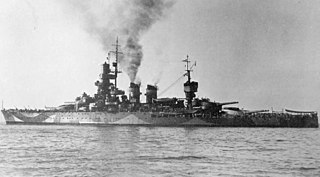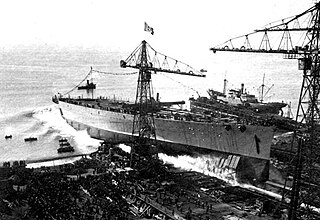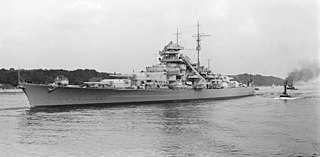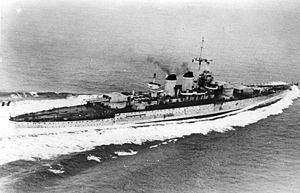
Giulio Cesare was one of three Conte di Cavour-class dreadnought battleships built for the Royal Italian Navy in the 1910s. Completed in 1914, she was little used and saw no combat during the First World War. The ship supported operations during the Corfu Incident in 1923 and spent much of the rest of the decade in reserve. She was rebuilt between 1933 and 1937 with more powerful guns, additional armor and considerably more speed than before.

Yamato (大和) was the lead ship of her class of battleships built for the Imperial Japanese Navy (IJN) shortly before World War II. She and her sister ship, Musashi, were the heaviest and most powerfully armed battleships ever constructed, displacing nearly 72,000 tonnes at full load and armed with nine 46 cm (18.1 in) Type 94 main guns, which were the largest guns ever mounted on a warship.

The King George V-class battleships were the most modern British battleships in commission during the Second World War. Five ships of this class were built: HMS King George V, HMS Prince of Wales (1941), HMS Duke of York (1941), HMS Anson (1942) and HMS Howe (1942). The names honoured King George V, and his sons, Edward VIII, who had been Prince of Wales, and George VI who was Duke of York before ascending to the throne; the final two ships of the class were named after prominent 18th century admirals of the Royal Navy.

Vittorio Veneto was the second member of the Littorio-class battleship that served in the Italian Regia Marina during World War II. The ship's keel was laid down in October 1934, launched in July 1937, and readied for service with the Italian fleet by August 1940. She was named after the Italian victory at Vittorio Veneto during World War I, and she had three sister ships: Littorio, Roma, and Impero, though only Littorio and Roma were completed during the war. She was armed with a main battery of nine 381-millimeter (15.0 in) guns in three triple turrets, and could steam at a speed of 30 knots.

Duilio was an Italian Andrea Doria-class battleship that served in the Regia Marina during World War I and World War II. She was named after the Roman fleet commander Gaius Duilius. Duilio was laid down in February 1912, launched in April 1913, and completed in May 1916. She was initially armed with a main battery of thirteen 305 mm (12.0 in) guns, but a major reconstruction in the late 1930s replaced these with ten 320 mm (13 in) guns. Duilio saw no action during World War I owing to the inactivity of the Austro-Hungarian fleet during the conflict. She cruised the Mediterranean in the 1920s and was involved in the Corfu incident in 1923.

The Littorio class, also known as the Vittorio Veneto class, was a class of battleship of the Regia Marina, the Italian navy. The class was composed of four ships—Littorio, Vittorio Veneto, Roma, and Impero—but only the first three ships of the class were completed. Built between 1934 and 1942, they were the most modern battleships used by Italy during World War II. They were developed in response to the French Dunkerque-class battleships, and were armed with 381-millimeter (15.0 in) guns and had a top speed of 30 knots. The class's design was considered by the Spanish Navy, but the outbreak of World War II interrupted construction plans.

The Scharnhorst class was a class of German battleships built immediately prior to World War II. The first capital ships of Nazi Germany's Kriegsmarine, it comprised two vessels: Scharnhorst and Gneisenau. Scharnhorst was launched first, and is considered to be the lead ship by some sources; they are also referred to as the Gneisenau class in some other sources, as Gneisenau was the first to be laid down and commissioned. They marked the beginning of German naval rearmament after the Treaty of Versailles. The ships were armed with nine 28 cm (11 in) SK C/34 guns in three triple turrets; plans to replace these with six 38 cm (15 in) SK C/34 guns in twin turrets were never realized.

Dunkerque was the lead ship of the Dunkerque class of battleships built for the French Navy in the 1930s. The class also included Strasbourg. The two ships were the first capital ships to be built by the French Navy after World War I; the planned Normandie and Lyon classes had been cancelled at the outbreak of war, and budgetary problems prevented the French from building new battleships in the decade after the war. Dunkerque was laid down in December 1932, was launched October 1935, and was completed in May 1937. She was armed with a main battery of eight 330mm/50 Modèle 1931 guns arranged in two quadruple gun turrets and had a top speed of 29.5 knots.

Trento was the first of two Trento-class cruisers; they were the first heavy cruisers built for the Italian Regia Marina. The ship was laid down in February 1925, launched in October 1927, and was commissioned in April 1929. Trento was very lightly armored, with only a 70 mm (2.8 in) thick armored belt, though she possessed a high speed and heavy main battery of eight 203 mm (8 in) guns. Though nominally built under the restrictions of the Washington Naval Treaty, the two cruisers significantly exceeded the displacement limits imposed by the treaty.

The Andrea Doria class was a pair of dreadnought battleships built for the Royal Italian Navy between 1912 and 1916. The two ships—Andrea Doria and Duilio—were completed during World War I. The class was an incremental improvement over the preceding Conte di Cavour class. Like the earlier ships, Andrea Doria and Duilio were armed with a main battery of thirteen 305-millimeter (12.0 in) guns.

Andrea Doria was the lead ship of her class of battleships built by the Regia Marina. The class included only one sister ship, Duilio. Andrea Doria was named after the 16th-century Genoese admiral of the same name. Laid down in March 1912, the battleship was launched a year later in March 1913, and completed in March 1916. She was armed with a main battery of thirteen 305 mm (12.0 in) guns and had a top speed of 21 knots.

Impero was the fourth Littorio-class battleship built for Italy's Regia Marina during the Second World War. She was named after the Italian word for "empire", in this case referring to the newly (1936) conquered Italian Empire in East Africa as a result of the Second Italo-Abyssinian War. She was constructed under the order of the 1938 Naval Expansion Program, along with her sister ship Roma.

Roma, named after two previous ships and the city of Rome, was the third Littorio-class battleship of Italy's Regia Marina. The construction of both Roma and her sister ship Impero was due to rising tensions around the world and the navy's fear that only two Littorios, even in company with older pre-First World War battleships, would not be enough to counter the British and French Mediterranean Fleets. As Roma was laid down almost four years after the first two ships of the class, some small improvements were made to the design, including additional freeboard added to the bow.

Fiume was a Zara-class heavy cruiser of the Italian Regia Marina, named after the Italian city of Fiume, she was the second of four ships in the class, and was built between April 1929 and November 1931. Armed with a main battery of eight 8-inch (200 mm) guns, she was nominally within the 10,000-long-ton (10,000 t) limit imposed by the Washington Naval Treaty, though in reality she significantly exceeded this figure.

The Cannone da 381/50 Ansaldo M1934 was a 381-millimeter (15 in), 50-caliber naval gun designed and built for the Royal Italian Navy by Gio. Ansaldo & C. in the 1930s. The gun served as the main armament of Italy's last battleships, the Littorio class. These built-up guns consisted of a liner, a cylinder over the chamber and part of the rifle bore, a full-length cylinder, and a 3/4 length jacket with a hydro-pneumatically operated side-swinging Welin breech block. 40 barrels were produced in total by Ansaldo and O.T.O., but none survive to this day. Each battleship carried nine guns mounted in three triple turrets with maximum elevation of 35°. Time between salvos was approximately 45 seconds.

The Bismarck class was a pair of fast battleships built for Nazi Germany's Kriegsmarine shortly before the outbreak of World War II. The ships were the largest and most powerful warships built for the Kriegsmarine; displacing more than 41,000 metric tons normally, they were armed with a battery of eight 38 cm (15 in) guns and were capable of a top speed of 30 knots. Bismarck was laid down in July 1936 and completed in September 1940, while her sister Tirpitz's keel was laid in October 1936 and work finished in February 1941. The ships were ordered in response to the French Richelieu-class battleships. They were designed with the traditional role of engaging enemy battleships in home waters in mind, though the German naval command envisioned employing the ships as long-range commerce raiders against British shipping in the Atlantic Ocean. As such, their design represented strategic confusion that dominated German naval construction in the 1930s.

Scharnhorst was a German capital ship, alternatively described as a battleship or battlecruiser, of Nazi Germany's Kriegsmarine. She was the lead ship of her class, which included her sister ship Gneisenau. The ship was built at the Kriegsmarinewerft dockyard in Wilhelmshaven; she was laid down on 15 June 1935 and launched a year and four months later on 3 October 1936. Completed in January 1939, the ship was armed with a main battery of nine 28 cm (11 in) C/34 guns in three triple turrets. Plans to replace these weapons with six 38 cm (15 in) SK C/34 guns in twin turrets were never carried out.

Gneisenau was a German capital ship, alternatively described as a battleship and battlecruiser, of Nazi Germany's Kriegsmarine. She was the second vessel of her class, which included her sister ship, Scharnhorst. The ship was built at the Deutsche Werke dockyard in Kiel; she was laid down on 6 May 1935 and launched on 8 December 1936. Completed in May 1938, the ship was armed with a main battery of nine 28 cm (11 in) C/34 guns in three triple turrets. Plans were approved, once construction had started, to replace these weapons with six 38 cm (15 in) SK C/34 guns in twin turrets, but as this would involve a lot of redesign, construction continued with the lower calibre guns. The intent was to make the upgrade in the winter of 1940–41, but the outbreak of World War II stopped this.

Tirpitz was the second of two Bismarck-class battleships built for Nazi Germany's Kriegsmarine (navy) prior to and during the Second World War. Named after Grand Admiral Alfred von Tirpitz, the architect of the Kaiserliche Marine, the ship was laid down at the Kriegsmarinewerft in Wilhelmshaven in November 1936 and her hull was launched two and a half years later. Work was completed in February 1941, when she was commissioned into the German fleet. Like her sister ship, Bismarck, Tirpitz was armed with a main battery of eight 38-centimetre (15 in) guns in four twin turrets. After a series of wartime modifications she was 2000 tonnes heavier than Bismarck, making her the heaviest battleship ever built by a European navy.






















